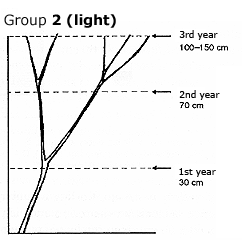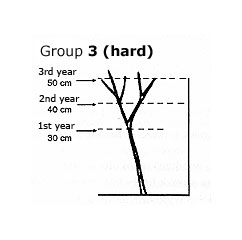Diseases & Pests
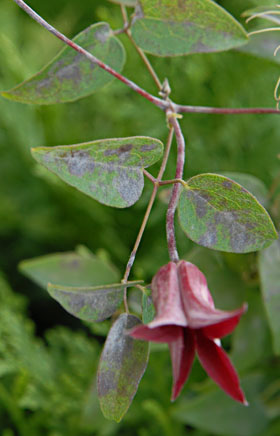 The only serious disease of clematis is highly infective fungal infestation called Clematis wilt. Suddenly either the entire plant, one of the shoots, or just part of a shoot collapses completely, although roots usually remain healthy.
The only serious disease of clematis is highly infective fungal infestation called Clematis wilt. Suddenly either the entire plant, one of the shoots, or just part of a shoot collapses completely, although roots usually remain healthy.
Powder mildewThis tends to affect weak, damaged or improperly cultivated plants. Buying clematis from reliable sources and planting only strong varieties, previously grown in a container can partially reduce the risk. Clematis should be planted deep in the ground in a carefully prepared site to ensure generous rooting of the stems close to the base. Before planting and also during cultivation all dead parts, both leaves and stems, should be removed. Wilt can be counteracted and fought chemically by watering the plant thoroughly with the 0.1% solution of fungicide Switch, if it’s registered in your country. Use 3-5 l of the solution for one plant and repeat this treatment 2-3 times every 10-14 days. Powder mildew is proving an ever more dangerous disease affecting clematis. A white powdery growth appears on the upper leaf surface. With the course of time the growth gets thicker and red or brown spots may appear and eventually, the infected leaves wither.
The susceptibility to the disease varies greatly from one cultivar to another. All clematis from the Texensis Group are particularly vulnerable, as well as some large-flowered cultivars e.g. ‘Romantica’, ‘Jackmanii’, and ‘Rooguchi’ and others from the Integrifolia Group. Temperature above 20oC and frequent moistening of the leaves promotes the spread of the disease. Drought stressed plants, grown in a partially-shaded position without proper air circulation are particularly prone to powdery mildew. In case of infection spray the plant straight after you’ve noticed the first symptoms of the disease with one of the currently recommended fungicide, for instance Rubigan 12EC (0,03%) or Saprol 190EC (0,15%), or Baycor 200EC (0,2%), if they are registered in your country. Repeat the treatment 2-3 times every 10 days, alternating the fungicide used.
PESTS
Pests don’t usually present a problem for clematis as they are on the whole less prone to attack than many other garden plants. There are no specific clematis pests and the assault from the most common spiders and aphis doesn’t happen too often. If they appear, however, a similar treatment should be applied as in the case of every other cultivation. A mouse is another burdensome pest.
It will eat the roots of the plant, which will eventually collapse. You can partially prevent the roots from damage by wrapping the rootball with a plastic or wire mesh.
Group 1 (none)
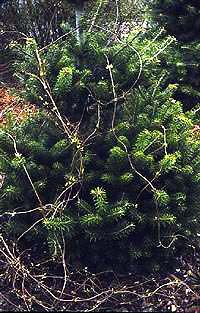 are varieties that flower only on growth produced the previous year: Clematises from Montana and Atragene Group. They are generally not pruned at all, but if it is necessary to prune some overgrowth, cut immediately after flowering, usually not lower than 1 m above the ground.
are varieties that flower only on growth produced the previous year: Clematises from Montana and Atragene Group. They are generally not pruned at all, but if it is necessary to prune some overgrowth, cut immediately after flowering, usually not lower than 1 m above the ground.
Popular varieties which should not be pruned:
Clematis armandii ‘Apple Blossom’
Clematis ‘Albina Plena’
Clematis ‘Lemon Dream’PBR
Clematis ‘Markham’s Pink’
Clematis ‘Purple Dream’PBR
Clematis ‘Stolwijk Gold’
Clematis cirrhosa var. purpurescens ‘Freckles’
Clematis japonica
Clematis montana ‘Elizabeth’
Clematis montana var. rubens
Clematis sibirica
Group 2 (light)
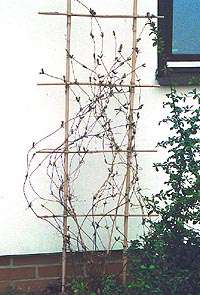 are the large-flowered varieties that begin to bloom in May or early June with the first flush of flowers appearing on the previous year’s growth, followed by a smaller flush on new growth. Pruning should consist of cutting shoots at a height of 100-150 cm from the base (the younger a plant the lower it should be cut). This is a safe way of pruning if we are unsure which category our plant falls into.
are the large-flowered varieties that begin to bloom in May or early June with the first flush of flowers appearing on the previous year’s growth, followed by a smaller flush on new growth. Pruning should consist of cutting shoots at a height of 100-150 cm from the base (the younger a plant the lower it should be cut). This is a safe way of pruning if we are unsure which category our plant falls into.
Popular varieties which should be pruned at a height of 100-150 cm:
Clematis ‘Andromeda’
Clematis ‘Beautiful Bride’ PBR
Clematis ‘Blue Light’
Clematis ‘Doctor Ruppel’
Clematis ‘Jan Paweł II’ JOHN PAUL II
Clematis ‘Multi Blue’
Clematis ‘Nelly Moser’
Clematis ‘Niobe’
Clematis ‘The President’
Clematis ‘Warszawska Nike’
Clematis ‘William Kennett’
Clematis ‘Xerxes’
Group 3 (hard)
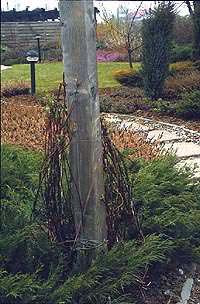 are later flowering species and varieties that bloom on new growth from the end of June to July e.g. cultivars from Viticella Group and Jackmanii Group. These should be hard pruned above second or third set of the buds, 20-50 cm from the ground. This pruning pattern should also be applied to vigorous vines if you want to reduce their growth: Clematis from Tangutica Group. As for herbaceous perennial clematis and cultivars from Texensis Group remove all dead stems just above the base, cut the rest 5-10 cm above the ground.
are later flowering species and varieties that bloom on new growth from the end of June to July e.g. cultivars from Viticella Group and Jackmanii Group. These should be hard pruned above second or third set of the buds, 20-50 cm from the ground. This pruning pattern should also be applied to vigorous vines if you want to reduce their growth: Clematis from Tangutica Group. As for herbaceous perennial clematis and cultivars from Texensis Group remove all dead stems just above the base, cut the rest 5-10 cm above the ground.
Popular varieties which should be pruned at a height of 20-50 cm:
Clematis ‘Błękitny Anioł’ BLUE ANGEL
Clematis ‘Comtesse de Bouchaud’
Clematis ‘Etoile Violette’
Clematis ‘Jackmanii’
Clematis ‘Krakowiak’ PINK MINK
Clematis ‘Mme Julia Correvon’
Clematis ‘Prince Charles’
Clematis ‘Princess Diana’
Clematis ‘Romantika’
Clematis ‘Rouge Cardinal’
Clematis ‘Sweet Summer Love’PBR
Clematis ‘Venosa Violacea’
Clematis crispa
Clematis fusca
Clematis x triternata ‘Rubromarginata’

